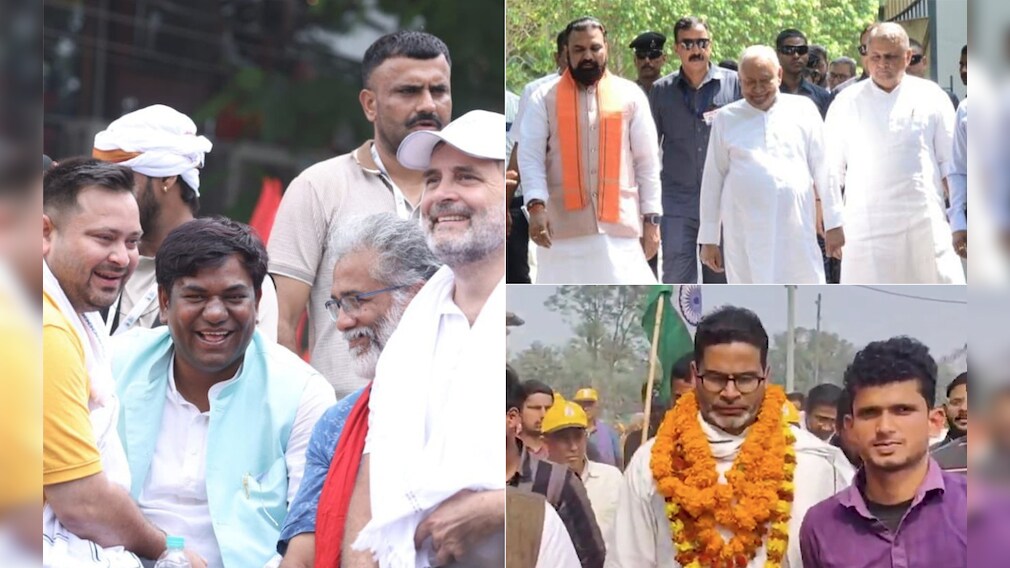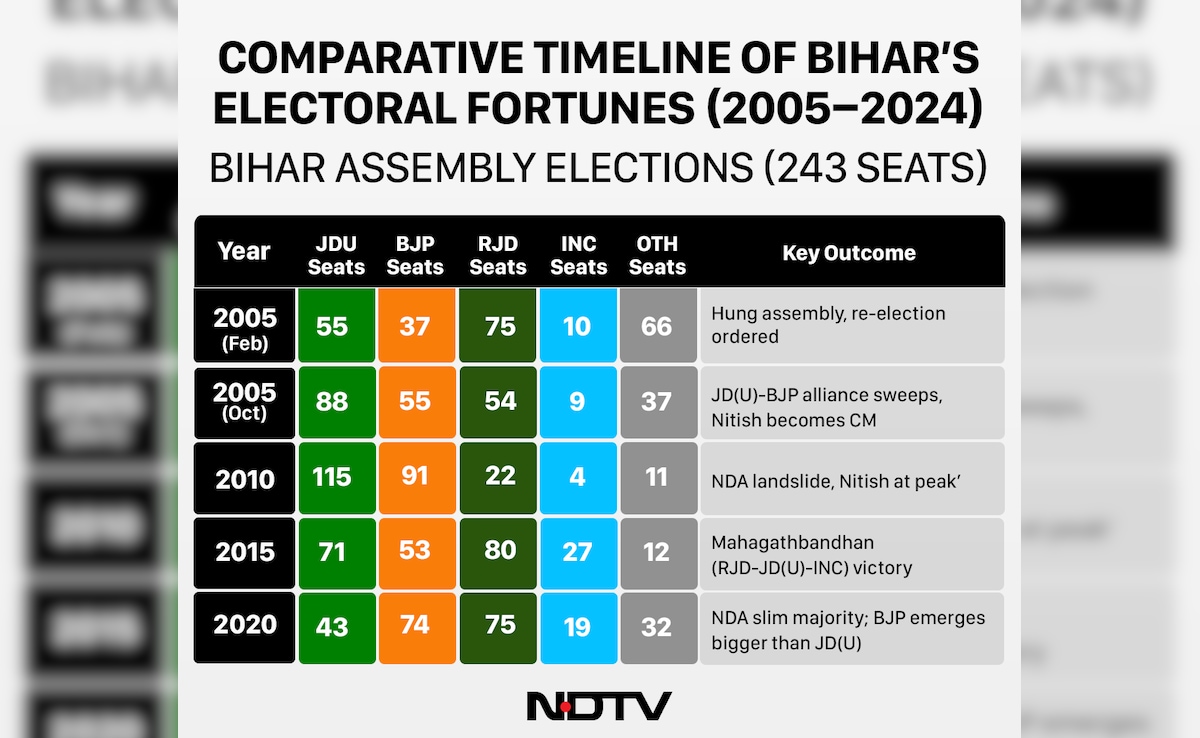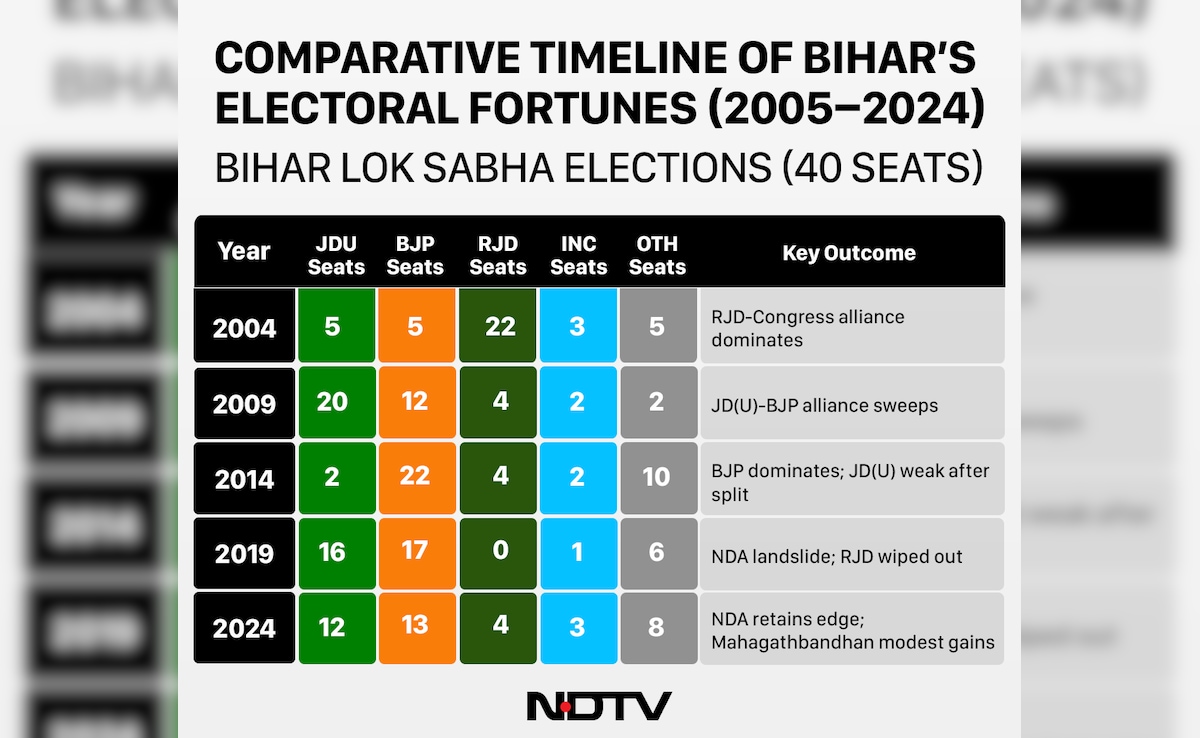Bihar's Battle Of Yatras: A Theatre Of Footsteps
As Bihar polls near, the air has grown heavy not only with the chants of slogans but with two distinct languages of persuasion: the orchestrated discipline of the BJP's karyakarta sammelans, and the restless, dust-laden wanderings of the Opposition's padyatras.

In Bihar, politics rarely arrives softly. It comes, instead, like the sound of drums on the far side of the Ganges - thick, insistent, travelling through the mist of the morning.
This autumn, as the state edges closer to elect a new assembly, likely in November, the air has grown heavy not only with the chants of slogans but with two distinct languages of persuasion: the orchestrated discipline of the BJP's karyakarta sammelans, and the restless, dust-laden wanderings of the Opposition's padyatras.
Saffron Sammelans: a silent choreography
The sammelan, in its essence, is a quiet choreography. Party workers gather in shaded halls or open tents, where saffron flags ripple like signals from another century. Here, the BJP speaks less to the masses than to its foot soldiers - the men and women who will carry the message into villages, who will whisper in courtyards, who will ensure that a speech in Patna finds resonance in far-flung hamlets in Champaran, Madhubani and Nalanda.
These meetings are less spectacle than strategy: they are about tightening screws, oiling the machine, ensuring that in the vast expanse of Bihar's 243 assembly constituencies, no booth is left unguarded, no narrative unpolished.
Padyatra is democracy on foot
The padyatra, by contrast, is democracy on foot. It is dust clinging to the kurta, children spilling into the roadside to glimpse a leader, women pausing from washing utensils at the hand pump to listen.
When Tejashwi Yadav walks, he carries his father's memory like an invisible banner; when Rahul Gandhi joins, it is the Congress's attempt at stitching together its faded fabric; when Dipankar Bhattacharya rallies, the slogans sharpen into a protest against inequality.
And then there is Prashant Kishor, moving like a surveyor across the state - less a politician than a cartographer of discontent, mapping grievances as if drawing the blueprint for a new Bihar. The padyatra is, at once, an endurance test and a theatre: its meaning lies as much in the journey as in the message, in the sight of a leader walking the same rutted paths as the people.
If the sammelan is about precision, the padyatra is about passion.
The BJP's strength lies in its ability to systematise - converting devotion into votes, energy into arithmetic.
In the booths of Bihar, elections are often won not by grand speeches but by the tenacity of the unseen worker. The padyatras, meanwhile, summon an older memory of politics: Gandhi's marches during the Champaran Satyagraha, Jayaprakash Narayan's calls from the streets during anti-Emergency protests, the idea that walking shoulder to shoulder is itself an act of legitimacy.
Which will weigh more heavily in November 2025? The BJP's sammelans, with their strategic clarity, may ensure the party does not falter where logistics are concerned; they transform politics into a well-drilled operation. Yet the padyatras-dusty, emotional, unpredictable-carry the chance to stir the mood, to awaken a restive electorate that often swings not by calculation but by sentiment.
Sammelans instruct, padyatras inspire
Bihar, after all, is a state where politics is lived in the body as much as in the mind. A sammelan can instruct, but a padyatra can inspire. The saffron cadres may guarantee efficiency, but the wandering marches can rekindle faith. As the monsoon gives way to winter and November approaches, Bihar will stand as it has so often in the past-between two imaginations of democracy: one disciplined, one disorderly; one organised, one improvisational.
In the end, perhaps, the voter will decide whether the future of Bihar is to be assembled like a machine in the BJP's sammelans, or walked into being on the long, weary roads of the padyatra.
Take Me Home, Country Roads
In the dust and silt of Bihar's highways, where sugarcane carts sway and the Ganga bends sluggishly around forgotten ghats, politics has returned to its oldest metaphor: the walk.
The state that once heard the hoofbeats of empires and the march of satyagrahis is now echoing with the sound of yatras - political pilgrimages that attempt to turn every by-lane into a referendum, every mile into a manifesto. While politicians of various hues walk the talk, Bihar's countryside seems to hum the Bhojpuri and Maithili version of John Denver's folk song: Take Me Home, Country Roads.
One can sense it in the charged air of autumn as election approaches. There is Rahul Gandhi, referred to as a dynast, stepping lightly into villages where children still call him "Rahul bhaiya" with a familiarity that borders on intimacy. His stride is less about conquest than about communion: pausing at roadside tea stalls, nodding at farmers who hold his hand longer than propriety requires, evoking his family's long shadows in this soil while promising a more democratic dawn.
Rahul's stride, Tejashwi's bounce
Tejashwi Yadav, younger, quicker, walks differently. He does not so much march as bounce, the son of Lalu, carrying both burden and blessing. Where Rahul offers memory, Tejashwi insists on youth. His yatra across the hinterland feels like a cricket innings in an endless Test match-measured but punctuated with sudden sweeps of rhetoric, appeals to jobs, to dignity, to the ordinary boy with ambitions greater than his salary slip.
For him, walking is less pilgrimage, more pursuit: chasing the promise that Bihar's youth can, finally, be more than migrants in other men's cities.
Deepankar Bhattacharya, the communist, has chosen the harder, quieter road. His 17-day, 1300-kilometre Voter Adhikar Rally across 110 constituencies has none of the motorcades or the posters.
Yet, it has a texture of stubborn idealism-an insistence that the poor still matter, that democracy must not only be spoken but walked, step by blistered step. He walks with the cadence of conviction, stopping not to wave but to listen, as if politics were less a spectacle than a whispered dialogue in the shade of a peepul tree.

P in Prashant Kishor stands for Precision: more Monk than Messiah
And then there is Prashant Kishor, who has been walking longer than all of them, almost two years now, as if he has decided that the only way to understand Bihar is to wear down the soles of his shoes on its every road, every panchayat, every neglected culvert.
The Jan Suraaj Party website describes its padyatra in the following way: "Jan Suraaj Padyatra is not just about walking on foot across Bihar, it's a movement to unite the people of Bihar and bring about change."
The website provides up-to-date figures of Padyatras undertaken. Total 665 days of Padyatras by August 9, 2025, covering 2,697 villages, 1,319 panchayats and 235 blocks.
P in Prashant Kishor stands for precision. PK's (as he is popularly known) march is less a politician's yatra than a strategist's experiment turned into a vow. Each district becomes a data set, each encounter a survey question asked in the language of lived life. His pace is steady, deliberate, more monk than messiah, and yet his very persistence has begun to feel like prophecy.
Walk the Talk
One watches them pass: Rahul with his nostalgia, Tejashwi with his restlessness, Deepankar with his austerity, Kishor with his persistence. And in their shadows, others too march-smaller leaders, party men, rivals of Nitish Kumar and Narendra Modi-hoping that the dust of the walk will cling to them as legitimacy.
Bihar has become a theatre of footsteps, a state where leaders are judged not by the crowds at their rallies but by the calluses on their feet.
The battle of the yatras is not merely electoral. It is symbolic, almost spiritual: in a state scarred by neglect and migration, where trains leaving Patna are more crowded than those arriving, walking is itself a metaphor for staying, for belonging, for refusing to leave. To walk Bihar's length is to tell its people: I am here, I will endure with you.
And yet, beneath the poetry of the march lies the arithmetic of the vote. Each step is counted, each kilometre mapped against constituencies and caste equations. The yatras may look like pilgrimages, but they are also campaigns in disguise, bearing the scent of incense and sweat, but also the ink of polling booths to come.

Did Deepankar's austerity stir conscience?
In November 2025, Bihar will not only vote-it will measure the weight of these journeys.
Did Rahul's footsteps awaken a memory? Did Tejashwi's stride capture aspiration? Did Deepankar's austerity stir conscience? Did Kishor's pilgrimage cut through cynicism? The answers will not be given in slogans but in seats. For now, Bihar watches, half-amused, half-hopeful, as its dusty roads become the stage of a peculiar contest-not of speeches, not of money, but of men who have chosen to walk, as if the future of democracy could be found in the very act of putting one foot before the other.
-
Why BJP's 'Double Engine' Needs Nitish Kumar In Bihar: A SWOT Analysis
This dilemma - needing Nitish's coalition arithmetic while chafing at his dominance - has defined the BJP's Bihar odyssey.
-
Opinion | Trump-Modi: True Healing Will Need More Than A Tweet
Today's posts by Trump are an opening overture, perhaps, but they are not yet a full thaw. They are a starting point, a test of how much the past can be forgiven and how quickly trust can be rebuilt.
-
Pics: Pak Rebuilds Nur Khan Base Section Destroyed By India During Op Sindoor
On May 10, India launched a missile attack targeting two special purpose trucks located within a complex.
-
Opinion | Pakistan First? Then Azerbaijan Should Stop Complaining About India
Baku would do well to do some soul-searching as to why pursuing close relations with Pakistan should necessarily translate into antagonism towards India.
-
Bihar's Woman Voter: Nitish Kumar's Silent Weapon, And NDA's Fresh Outreach
Election after election, women voters have emerged as a key factor in victories and losses of political heavyweights.
-
The Importance Of Being Nitish Kumar In Bihar
In Bihar's ledger of seasons, Nitish Kumar's career reads like a long monsoon: the early downpour of 2005-10, the pause and reversal of 2014-15, the fitful showers since.
-
Opinion | RSS At 100: Contradictions Of Imagination
Bhagwat said that except for certain core tenets, everything in the RSS is open to change. That flexibility will be useful for the RSS leadership, which has its job cut out as it tries to steer the ship into open international waters.
-
Opinion | To Survive Trump, India Needs More Than Just Handshakes With Xi And Putin
The resilience of the Indian economy will outlast Trump's tariff agenda, but it's time India fixed its priority list and embarked on a journey of reforms with quiet dignity.
-
'Vikram 3201': 'Aatmanirbhar Bharat's' Deep-Space Microchip, A Game-Changer
Nearly every modern electronic item needs microchips, and India is positioning itself to be a key player in this space, competing against Taiwan, China, South Korea, and the United States.
-
Opinion | Modi-Xi Meet, And Everything That Was Left Unsaid At Tianjin
The warm smiles exchanged at the feverishly covered meeting between Modi and Xi neither mean that India is dumping the West completely, nor that all is finally well between India and China. It's complicated, still.
-
News Updates
-
Featured
-
More Links
-
Follow Us On










